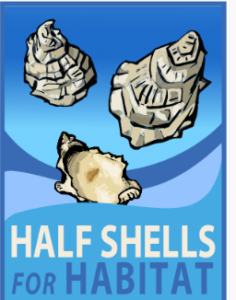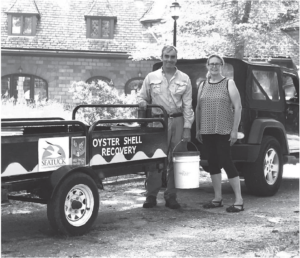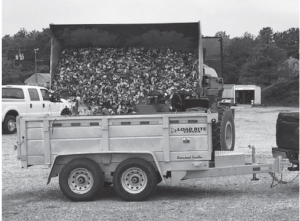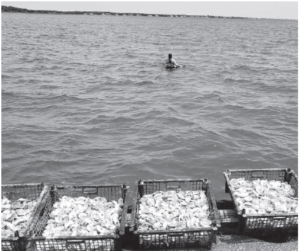 Did you know that one little oyster filters 50 gallons of water a day? These mighty mollusks are a huge part of Long Island’s aquaculture that are keeping some special people incredibly busy by paving the way for their return.Town of Brookhaven recently unveiled the first Long Island “oyster bar” at Moriches Bay – however it’s sitting room for oysters only. Laura Fabrizio, co-founder of the Moriches Bay Project, now it’s sixth summer, said the newly introduced project was 15 months in the making, resulting in some positive numbers.“Our main goal at the Moriches Bay Project is to improve water quality,” said Fabrizio. “Thanks to this project, we’ve reached our goal of adding 750,000 oysters in the bay, which will mean 3.5 million gallons of water being filtered a day.”Maureen Dunn, water quality scientist, at Seatuck Environmental Association helps run the Half Shells for Habitat Oyster Recovery Program. The program is one of the backbones of the Moriches Bay Oyster Bar, as it entails local restaurants keeping and donating used oyster shells that are necessary for the project’s survival. Seatuck volunteers drive to numerous eating establishments weekly to pick up the used shells, then bring them to The Town of Brookhaven’s composting sight, where they are cured for at least six months, in order to become sanitized.
Did you know that one little oyster filters 50 gallons of water a day? These mighty mollusks are a huge part of Long Island’s aquaculture that are keeping some special people incredibly busy by paving the way for their return.Town of Brookhaven recently unveiled the first Long Island “oyster bar” at Moriches Bay – however it’s sitting room for oysters only. Laura Fabrizio, co-founder of the Moriches Bay Project, now it’s sixth summer, said the newly introduced project was 15 months in the making, resulting in some positive numbers.“Our main goal at the Moriches Bay Project is to improve water quality,” said Fabrizio. “Thanks to this project, we’ve reached our goal of adding 750,000 oysters in the bay, which will mean 3.5 million gallons of water being filtered a day.”Maureen Dunn, water quality scientist, at Seatuck Environmental Association helps run the Half Shells for Habitat Oyster Recovery Program. The program is one of the backbones of the Moriches Bay Oyster Bar, as it entails local restaurants keeping and donating used oyster shells that are necessary for the project’s survival. Seatuck volunteers drive to numerous eating establishments weekly to pick up the used shells, then bring them to The Town of Brookhaven’s composting sight, where they are cured for at least six months, in order to become sanitized. Both Dunn and Fabrizio were not shy at all about mentioning the fact that Town Supervisor Ed Romaine and Daniel Panico, Councilman and Deputy Supervisor of the Town of Brookhaven, have been incredibly supportive throughout the entire process, and agree that the program may not exist today without their assistance.
Both Dunn and Fabrizio were not shy at all about mentioning the fact that Town Supervisor Ed Romaine and Daniel Panico, Councilman and Deputy Supervisor of the Town of Brookhaven, have been incredibly supportive throughout the entire process, and agree that the program may not exist today without their assistance. “Town regulations are strict and Romaine helped get the necessary permits, along with getting the composting facility space in the Town of Brookhaven for the project,” said Fabrizio. Dunn’s sentiments echoed this.After the curing process at the above site, the shells are brought to Cornell Cooperative Extension to become part of the spat-on-shell process led by Gregg Rivara, aquaculture specialist at Suffolk County Marine Environmental Learning Center (SCMELC.) What’s spat? It’s the oyster larvae once it’s attached to a surface.“This process is done in the hatchery because in nature young larval oysters are very vulnerable,” said Dunn.According to Fabrizio, shells will be added to the reef throughout the season, but we’ll have to wait until next year to find out if this particular bar is considered successful.To help build some incentive for restaurant owners to join Half Shells for Habitat in its collection of used shells, Seatuck has been fighting for some important new legislation. “We have been an advocate for legislation that gives a small tax credit to restaurants that recycle shells,” said Dunn. “Although the bill was introduced to the New York State Legislature, it did not get passed into law this year. We plan to have it reintroduced and we will pursue it again in 2020.”“This is a pilot project,” Rivara said. “It’s only about 500 square feet. We will be monitoring for the next [DEC required] four years, and hope to expand this bar and create others in the future.”
“Town regulations are strict and Romaine helped get the necessary permits, along with getting the composting facility space in the Town of Brookhaven for the project,” said Fabrizio. Dunn’s sentiments echoed this.After the curing process at the above site, the shells are brought to Cornell Cooperative Extension to become part of the spat-on-shell process led by Gregg Rivara, aquaculture specialist at Suffolk County Marine Environmental Learning Center (SCMELC.) What’s spat? It’s the oyster larvae once it’s attached to a surface.“This process is done in the hatchery because in nature young larval oysters are very vulnerable,” said Dunn.According to Fabrizio, shells will be added to the reef throughout the season, but we’ll have to wait until next year to find out if this particular bar is considered successful.To help build some incentive for restaurant owners to join Half Shells for Habitat in its collection of used shells, Seatuck has been fighting for some important new legislation. “We have been an advocate for legislation that gives a small tax credit to restaurants that recycle shells,” said Dunn. “Although the bill was introduced to the New York State Legislature, it did not get passed into law this year. We plan to have it reintroduced and we will pursue it again in 2020.”“This is a pilot project,” Rivara said. “It’s only about 500 square feet. We will be monitoring for the next [DEC required] four years, and hope to expand this bar and create others in the future.” While most of this project is all positive, some boaters have expressed concern about the reef interfering with navigation. Rivara wants to assure them that it will not.Seatuck Environmental, Moriches Bay Project, and Cornell Cooperative Extension are all in need of and welcoming of volunteers for their programs. This includes Fire Islanders who are interested in helping. “We are hoping to bring more participating restaurants and volunteers from Fire Island onboard to help recycle oyster shells.” said Dunn.Rivara also contributed some food for thought: “Eat more locally-grown oysters!”
While most of this project is all positive, some boaters have expressed concern about the reef interfering with navigation. Rivara wants to assure them that it will not.Seatuck Environmental, Moriches Bay Project, and Cornell Cooperative Extension are all in need of and welcoming of volunteers for their programs. This includes Fire Islanders who are interested in helping. “We are hoping to bring more participating restaurants and volunteers from Fire Island onboard to help recycle oyster shells.” said Dunn.Rivara also contributed some food for thought: “Eat more locally-grown oysters!”































